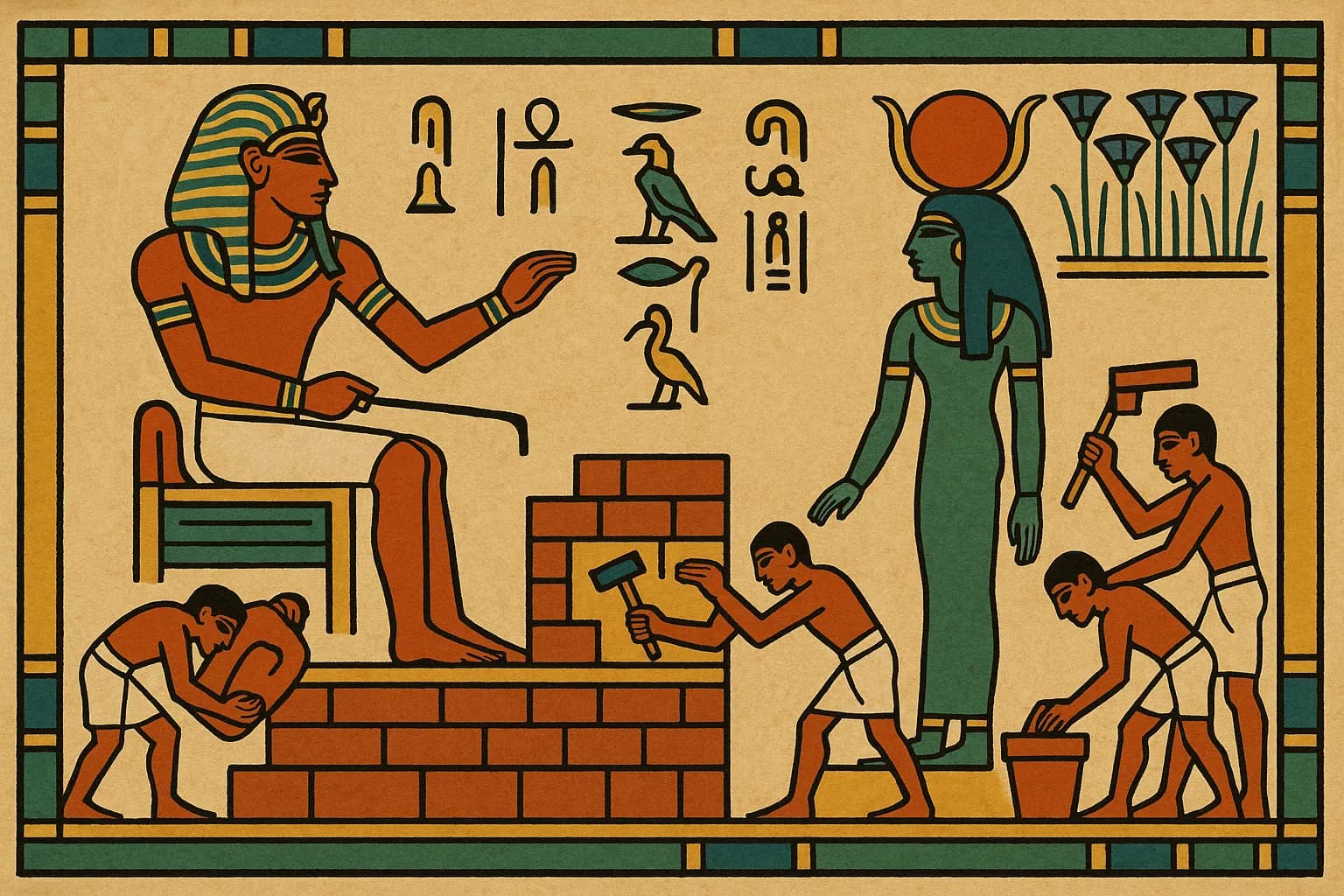Ancient Egyptian Art
4 min read

Period: c. 3100 BCE – 30 BCE (Dynastic Period) Region: Ancient Egypt (Nile Valley)
Overview & Key Characteristics
Ancient Egyptian art spans nearly 3,000 years of history, characterized by remarkable consistency and adherence to strict conventions. Its primary purposes were religious and funerary (serving the gods, facilitating the journey to the afterlife, maintaining cosmic order or Ma'at) and political (communicating the divine power and authority of the pharaoh). Key forms include monumental architecture (pyramids, mastabas, temples), sculpture (statues, reliefs), painting (often on tomb walls or papyrus), and intricate decorative arts. Functionality, symbolism, and the pursuit of permanence and eternity were paramount.
Summary of Common Characteristics:
| Feature | Characteristic Description |
|---|---|
| Light | Symbolic rather than naturalistic depiction; even lighting implied. Relief carving utilizes shadow play. |
| Surface/Texture | Idealized smooth finishes on stone/wood sculpture. Flat paint application (often fresco secco) on plaster or papyrus. |
| Figures | Composite View (Aspectivism): Head profile, frontal eye, frontal torso, profile limbs. Idealized forms for elites/pharaohs; more naturalism for lower status/animals. Hierarchical Scale: Size indicates importance. |
| Space/Depth | Conceptual Space: Flat, minimal overlap. Depth suggested by registers (stacked horizontal bands) or symbolic arrangement. No geometric perspective. |
| Color Palette | Symbolic Colors from mineral pigments: Red (life/victory/danger), Yellow/Gold (divinity/eternity), Blue (Nile/sky/creation), Green (fertility/rebirth), Black (afterlife/fertility), White (purity/sacredness). Applied in flat areas. |
| Composition | Orderly & Stable: Often symmetrical, based on grids for proportion. Clear registers organize narratives. Emphasis on balance, clarity, and permanence. |
| Details/Lines | Clear, incised, or painted outlines. Precise carving in reliefs. Hieroglyphs often integrated as both text and decorative elements. |
| Mood/Emotion | Predominantly formal, serene, eternal, calm, and ordered. Conveys stability and divine authority, not fleeting human emotions (with exceptions like the Amarna period). |
| Subject Matter | Pharaohs (rituals, warfare, divine status), Gods & Goddesses (mythology, worship), Funerary scenes (afterlife journey, judgment, offerings), Daily life (farming, crafting, banquets - primarily in tombs), Hieroglyphic inscriptions. |
A notable, albeit short-lived, departure from these conventions occurred during the Amarna Period (c. 1353–1336 BCE) under Pharaoh Akhenaten, which featured more curvilinear forms, exaggerated features, intimate family scenes, and a sense of movement.
Historical Context & Influences
Egyptian civilization was profoundly shaped by the Nile River, whose predictable floods enabled agriculture and stability. Key contextual factors include:
- A highly centralized state ruled by a pharaoh considered a living god or intermediary.
- A complex polytheistic religion with a strong focus on the afterlife, requiring tombs, provisions, and rituals.
- A hierarchical society (pharaoh, priests, nobles, scribes, artisans, farmers, laborers).
- The development and ubiquitous use of hieroglyphic writing.
- Relative geographic isolation, which fostered cultural continuity, though interactions with Nubia, the Near East, and later Greece/Rome did occur.
- Abundant stone resources (limestone, sandstone, granite) facilitated monumental building.
The primary influences were internal: religious dogma, political ideology, social structure, and the natural environment dictated artistic production.
Key Artists & Their Contributions
Most Egyptian artists were anonymous artisans working in workshops associated with temples or the royal court. Skill and adherence to convention were valued over individual expression.
- Imhotep (Old Kingdom, c. 2667–2600 BCE): Served Pharaoh Djoser as chancellor, high priest, and architect. Designed the Step Pyramid at Saqqara, the earliest colossal stone structure. Revered in later periods as a god of wisdom and medicine.
- Bak (New Kingdom, c. 1353–1336 BCE): Served as Chief Sculptor during Akhenaten's reign. An inscription suggests Akhenaten personally instructed him, potentially linking Bak to the distinctive Amarna style (e.g., colossal statues of Akhenaten, Bust of Nefertiti - though attribution is debated).
Notable Works / Sites
- Old Kingdom (c. 2686–2181 BCE): Step Pyramid of Djoser (Saqqara), Pyramids and Sphinx of Giza, statues like Khafre Enthroned, Rahotep and Nofret, Seated Scribe, Sheikh el-Beled.
- Middle Kingdom (c. 2055–1650 BCE): Rock-cut tombs with paintings (Beni Hasan), more introspective or realistic royal portraiture (e.g., heads of Senusret III), elaborate jewelry (pectorals).
- New Kingdom (c. 1550–1070 BCE): Vast temple complexes of Karnak and Luxor, Mortuary Temple of Hatshepsut (Deir el-Bahri), Colossi of Memnon, Abu Simbel temples, Valley of the Kings tombs (esp. Tomb of Tutankhamun and its treasures, including his mask), Tomb of Nefertari paintings, Amarna Period art (Bust of Nefertiti, reliefs from Amarna), illustrated papyri (Book of the Dead).
Legacy and Influence
Ancient Egyptian art exerted a profound and lasting influence:
- Its monumentality and architectural forms (columns, pylons, obelisks) influenced Greek and Roman architecture, and experienced revivals ("Egyptomania") in later Western art (e.g., Neoclassicism, Art Deco).
- Early Greek Kouros statues show clear stylistic similarities to Egyptian standing figures.
- It established enduring conventions for representing power, divinity, and the afterlife in art.
- The integration of text (hieroglyphs) and image was highly developed.
- Its distinctive style, intricate symbolism, and connection to a complex belief system continue to fascinate and inspire artists, historians, and the public worldwide.